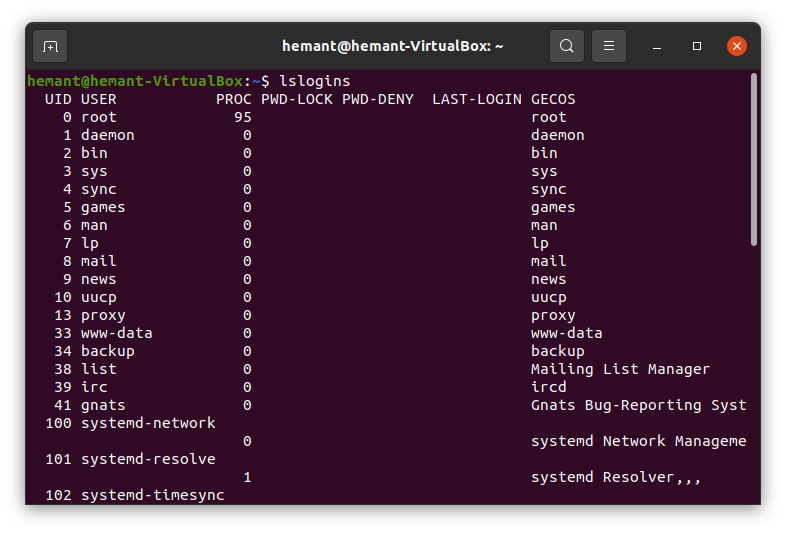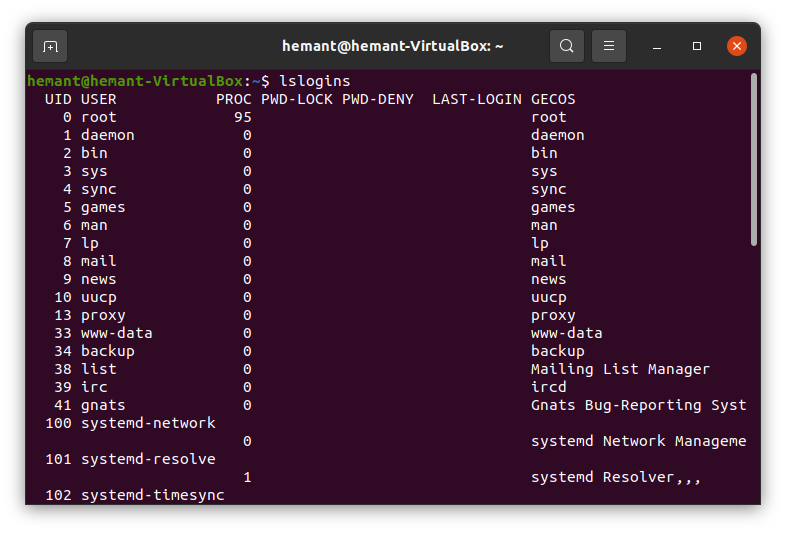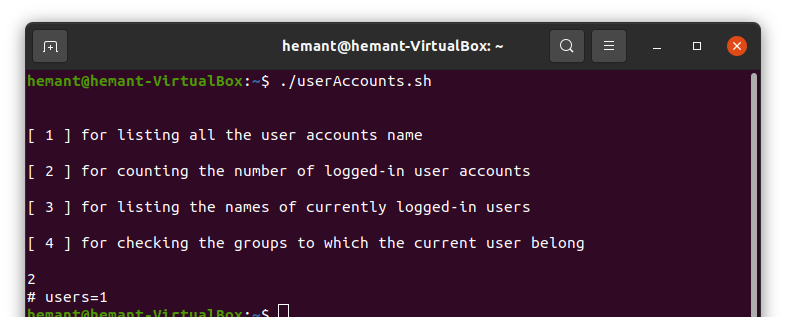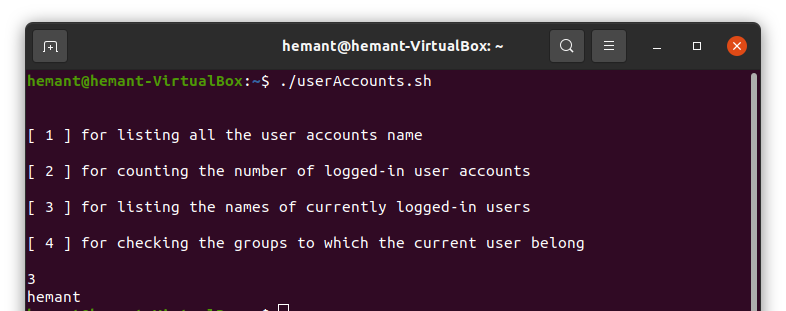用于查找登录用户数的 Shell 脚本
每个操作系统都提供多用户帐户的功能。基于 Linux 的操作系统有一些命令或功能来检查用户帐户的详细信息并进行更改。此能力主要由作为 root 用户的 admin 帐户用户使用,为不同的用户提供权限和访问权限。管理员还可以检查当前登录的用户数量、注销的用户数量以及登录时间。在本文中,我们将探索所有这些方式,并编写一个 shell 脚本来高效地完成这些任务。
获取用户相关信息的命令:
1、id: id命令用于打印指定USER的用户和组信息。
-a ignore, for compatibility with other versions
-Z, --context print only the security context of the process
-g, --group print only the effective group ID
-G, --groups print all group IDs
-n, --name print a name instead of a number, for -ugG
-r, --real print the real ID instead of the effective ID, with -ugG
-u, --user print only the effective user ID
-z, --zero delimit entries with NUL characters, not whitespace
此 id 命令已生成所有用户标识符、组标识符和组。如果您只需要一个组标识符,请使用以下命令。
id -G
2. 组:这将打印指定用户所属的组。如果没有给出特定的用户名,它将搜索当前用户。对当前用户使用以下命令。

3. getent:此命令显示数据库中的条目。
-i, --no-idn disable IDN encoding
-s, --service=CONFIG Service configuration to be used
-?, --help Give this help list
--usage Give a short usage message
-V, --version Print program version让我们看看我们系统上存在的 getent 程序的版本。
getent -V
4. lslogins:查看所有用户名和用户 ID。这提供了几个功能的列表,如 UID、用户、最后登录等。
-a, --acc-expiration display info about passwords expiration
-c, --colon-separate display data in a format similar to /etc/passwd
-e, --export display in an export-able output format
-f, --failed display data about the users' last failed logins
-G, --supp-groups display information about groups
-g, --groups= display users belonging to a group in
-L, --last show info about the users' last login sessions
-l, --logins= display only users from
-n, --newline display each piece of information on a new line
--noheadings don't print headings
--notruncate don't truncate output 

5. users:该命令将打印登录到当前主机的用户名。
users
这是当前唯一登录的用户。
6. 谁:显示谁已登录。这列出了具有 id 的用户以及用户登录的时间和日期。
-a, --all same as –b, -d, --login, -p, -r, -t, -T, -u
-b, --boot time of last system boot
-d, --dead print dead processes
-H, --heading print line of column headings
-l, --login print system login processes
--lookup attempt to canonicalize hostnames via DNS
-m only hostname and user associated with stdin
-p, --process print active processes spawned by init
-q, --count all login names and number of users logged on
7. w: w 命令显示登录的用户帐户并显示他们在做什么。
-h, --no-header do not print header
-u, --no-current ignore current process username
-s, --short short format
-f, --from show remote hostname field
-o, --old-style old style output
-i, --ip-addr display IP address instead of hostname (if possible)这比 who 具有更多的功能和列,以提供有关用户的更多详细信息。
w
8. last 或 lastb: last 和 lastb 命令显示最后登录的用户列表
- how many lines to show
-a, --hostlast display hostnames in the last column
-d, --dns translate the IP number back into a hostname
-f, --file use a specific file instead of /var/log/wtmp
-F, --fulltimes print full login and logout times and dates
-i, --ip display IP numbers in numbers-and-dots notation
-n, --limit how many lines to show
-R, --nohostname don't display the hostname field
-s, --since 这会根据日期和时间提供多个用户的所有登录详细信息。
last
9. lastlog:这将生成所有最近登录用户的报告。如果指定,这也可以创建单用户报告。
-b, --before DAYS print only lastlog records older than DAYS
-C, --clear clear lastlog record of a user (usable only with -u)
-h, --help display this help message and exit
-R, --root CHROOT_DIR directory to chroot into
-S, --set set lastlog record to the current time (usable only with -u)
-t, --time DAYS print only lastlog records more recent than DAYS
-u, --user LOGIN print lastlog record of the specified LOGIN这讲述了用户的最新日志。
lastlog
外壳脚本
现在我们将使用一些上述命令创建一个 shell 脚本来获取用户详细信息。我们正在以一种通过给定建议要求用户输入的方式来接近解决方案。然后,该输入将用于检查可用案例,然后将允许运行匹配的案例。
打开 gedit 文件:
根据您的喜好打开任何编辑器,我们使用 gedit 编辑器是因为它简单的用户界面和现有的颜色组合。
gedit userAccounts.sh代码:
在 userAccounts.sh 中,我们将编写我们的代码,并使用 switch case 来比较用户输入。我们使用了 lslogins、who、groups 等命令来帮助我们满足用户需求。您可以在上面找到更多扩展这些命令的使用。那么,让我们开始编写脚本。
#!/bin/bash
#here we are you going to develope a script for various options on user accounts
echo -e "\n
[ 1 ] for listing all the user accounts name \n
[ 2 ] for counting the number of logged-in user accounts \n
[ 3 ] for listing the names of currently logged-in users\n
[ 4 ] for checking the groups to which the current user belong \n"
#Now take user input
read userInput
#Now we will use switch cases for various input operations
case $userInput in
1)
#syntax lslogins
lslogins -o USER
;;
2)
#syntax who 
授予可执行权限
必须向文件授予可执行权限才能使它们在系统上运行或执行。我们也可以在 chmod 命令中使用“777”而不是“+x”。另外请以root身份运行脚本
# chmod +x userAccounts.sh
运行脚本
./userAccounts.sh示例 1:
./userAccounts.sh
1
示例 2:
./userAccounts.sh
2
示例 3:
./userAccounts.sh
3
因此,我们能够使用我们的 shell 脚本找出各种与登录相关的结果。